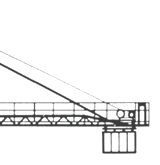The origins of our modern monsters of steel trails all the way back to medieval times. Human beings always tried to use technology for moving the soil to retrieve the commodities beneath it. Gold, silver and especially iron ore (important for the manufacture of tools and weapons) were the essential ingredients of a better life. Later, during industrialisation, coal entered the market as a fuel of increasing importance. Those treasures were hidden beneath a layer of what miners call the overburden.
The overburden – a layer of barren rock – had to be removed to enable retrieving of the commodity. Today, every human being on Earth uses 50 to 70kg of raw materials every day. To retrieve it, every year 20 billion cubic metres of rock have to be dug out, loaded and dumped again. This task is performed literally by “Monster diggers” on a day to day base.
Around 1850 – The birth of the excavator
The railway had been invented and first larger companies and industries emerged everywhere in rapid manner. The demand for brown coal rose enormously and along the methods of effective mining developed. The steam engine was the first available way to mechanically power a “digger“. The first shovel excavator was built in the US. It featured a 1.1 cubic metre shovel. It travelled on railways and it had only limited swivel capabilities to the left or right. Chains were used to move the arm, later replaced by steel cables. Such an early excavator could replace 50 to 80 manual labourers. The first excavator that featured a full 360° slew had been built in England in 1890. It had a weight of 10 tons.
The year 1900 - The first Giants
The first large excavators were used for open cast mining of coal. As the demand for this fuel type increased rapidly, the need for more powerful machinery grew with it. In 1907 a 1.9 cubic metre shovel excavator was used in Kentucky to remove overburden. One key problem of the increasingly heavy machines was how to move them around: Most excavators had to use rails as wheels would have sunk into the soil. However, the herewith connected requirement for track laying was cumbersome and tedious. A better solution was being sought after. Around 1912 the Caterpillar company successfully tested the first caterpillar track for excavators up to 60 tons. This new means of motion spread rapidly as being the by far faster way for an excavator to move around. However, the heavier machines still sunk into the ground. About a year later, a young engineer invented a completely different solution: The walking excavator.
This type of digger features a large base plate on which the machine rests while the digging progresses. When the machine needs to be moved, on both sides a walking mechanism gets into action: Like giant shoes, an excentric motion pushes the entire machine forward. The main advantage of this spectacular looking way to move around is that the excavator can be used even on soft grounds.
Around 1925 – The electric drive
The steam drive got replaced by the electric motor. The advantages are the more compact build, less wear and a much easier operation. While at least three workers were required to keep the steam machines running, now only a cable had to be laid out to follow the moving machine. The largest shovel excavator worldwide was then the Marion 5480-E. With a weight of 930 tons and 9.5 cubic metres shovel volume it was a true monster digger. As the ratio between barren rock and lignite became increasingly larger (layers of 30 metres and more had to be removed to get to the brown coal), the mining companies demanded even larger excavators. In 1929 it was again an American Marion excavator that broke the world record of being the biggest one: The Marion 5600 weighted 1600 tons, had 15 cubic metres shovel volume and a reach of almost 40 metres. 30 electric motors created 2500 horse powers. Only one was ever built, as there was the belief that this type of machine had reached a final frontier in size. However: What followed in the 1960s proved them wrong.
The 1940s – The time of engineering
In those times the excavators did not grow in size (meaning their weight), but in shovel volume. The engineers recognized that they could not just simply increase the size of a machine as there were too many disadvantages involved. Often the base did not last very long due to the weight. The mass that had to be accelerated and decelerated with each slew strained the bearings so much, that after some years enormous wear became visible, giving rise to timeouts or even to the complete writeoff of a machine. The main goal in those times was to increase the shovel volume. To remember: The Marion 5600 of 1600t weight had a shovel capacity of 15 cubic metres. In 1935, a Bucyrus-Erie excavator was able to move 23 cubic metres while weighing “only” 1200t, and it was able to lift the load 50 meters upwards. This gain in shovel capacity had been enabled by use of stiffer and harder materials and by long experience as well.
The 1950s - The monsters keep growing
During this decade the most economic way of mining lignite was a high priority. As the wages in the western countries rose, cost reduction by decreasing the staff became attractive. Hence the monster diggers grew again. In 1956, Marion introduced the „Mountaineer“ (the miner). The eight caterpillar tracks of this giant had to carry nearly 2500t, while the shovel carried 46 cubic meters at once. An elevator inside brought the mechanic and the driver to work. Another problem – different but related – was the way how to move the soil. The tipper trucks could not keep pace with the excavators: With 170t capacity the Euclid was the largest dumper truck in 1959, but it was still too small.
Around 1960 – The giant amongst the monsters
Some flew to the moon, while others built the largest bucket excavator of all times. In this decade everything seemed feasible, but still the human recognised borders. In 1965 the largest bucket excavator of all times was born: The Capitain, the giant amongst the monsters. 12650t of steel, 250t shovel capacity, 32 electric motors adding up to 29500 h.p. – alone this numbers are enourmous, but to really understand the size, one engineer stated: “We have to design the arm in a way you would build a large steel bridge which you then use for fishing.”. This giant moved up to 3.5 million cubic meters rock per month, using the electricity of a small town. The Capitain is still today the largest shovel excavator, as the excavator sizes went backwards in the decades after, partly due to dwindling demand of coal. However, a revolution in excavator construction was due.
Around 1970 - The Revolution
Until now, most kinematics of the arm was perfomed by cables that ran over pulleys to the drive mechanism. This was a proven, powerful, but also complicated mechanism. The new technology was called hydraulics: The engine drives a pump that presses oil through control valves through flexible conducts at which end a telescopic cylinder does the work. This method was not that new – experiments dated back to the 1920s. However, for a long time this technique could not compete against the proven pulley and cable method. Especially at large machines, a higher pressure was necessary what hit the boundary of what was available in those times. Often conduits or valves broke, or the speed was inferior when compared to the cable. For that reason, one of the first large hydraulic excavators (the O&K RH60) was just 110t in weight, operating a 7 cubic meter shovel. But development went on and at the end of the decade the second generation with 400t weight was ready to go.
The 1980s – The new system matures
The end of the cable and pulley dominance was due. Even when still today large cable excavators of all kinds are being built, the majority of contemporary excavators move hydraulically. Also the German excavator business made use of this, and most manufacturers of those days were German. The shovel volume exceeded 20 cubic meters. In 1980, the RH300 of O&K was the largest one for a long time. With 514t weight and a 20 cubic metre shovel was he the top notch of large hydraulic machines. However, there was no large success with this machine. In 1986, another German manufacturer had more luck with it’s largest machine: DEMAG presented the H485. With 475t and 23 cubic meters shovel volume this one was not larger, but much more successful. Within 10 years, 25 of them were sold around the world.
Around 1990 – The progress in electronics
The excavators matured. There were barely any weak points, and increasingly environmental thoughts influenced their design. Especially at large machines, the fuel consumption had to be lowered. For this reason, the electronics progressed into the control racks - at the beginning encountered with distrust, especially of the older generation of operators. They argued that the electronics was prone to fail and difficult to handle – but their arguments did not stop the progress of the computer controlled excavator.
At the size front in 1997 a new milestone was reached: Again an O&K machine, the RH400 with 800 t mass and over 40 cubic meters bucket capacity became the largest hydraulic excavator until now. This giant runs at 3500 h.p. and eight pumps keep 13000 liters of oil moving.
To show backwards: 1929 the Marion 5600 had a mass of 1600t with only a 15 cubic metre shovel. Six years later the Bucyros-Erie carried 23 cubic meters while only being of 1200 t weight. 1997 saw 42 cubic meters with a total weight of only 840t ! So the ratio between total mass and shovel capacity shrank, last but not least caused by the electronics.
We passed the year 2000 now – the future of the monster excavators including. We do not know today what mankind will do tomorrow, but one for sure: As long mankind deals with our planet, excavators will exist and there will be always one really astonishing one – the “monster-digger” !


